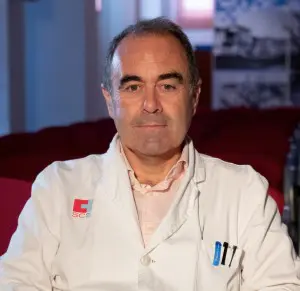HEALTH | 08.25.2020
“We must try to control the epidemic in small bubbles, both in schools and in our social sphere”
 Interview with Marcos López, Head of Immunology at the Marqués de Valdecilla University Hospital, Scientific Director of research at IDIVAL, and President of the SEI (Sociedad Española de Inmunología — Spanish Society of Immunology).
Interview with Marcos López, Head of Immunology at the Marqués de Valdecilla University Hospital, Scientific Director of research at IDIVAL, and President of the SEI (Sociedad Española de Inmunología — Spanish Society of Immunology).
Question (Q).: You are very active in your role as researcher and speaker, and have gained media traction. What is the most common question you get asked in the context of this surge in contagion?
Answer (A): Whether we are facing a second wave of infections and whether or not the virus is more aggressive than it was in March/April. The virus is currently just as lethal and infectious. All that has changed is that we have increased PCR testing and contact tracing, so more cases are being identified.
Q: Will we get a Spanish vaccine soon?
A: I believe that we will have an advanced Spanish vaccine in 2021 and it is essential that we do. There are up to 12 Spanish vaccine candidates. Two of these, from the CNB (Spanish National Centre for Biotechnology) of the CSIC (Spanish National Research Council) [to whose research Fundación MAPFRE donated 5 million euros], are currently very advanced. These are the work of Mariano Esteban and Juan García, and the work of Isabel Solá and Luis Enjuanes.
Esteban’s team is quite far along; they expect to start an initial Phase 1 trial with human subjects in the latter part of this year to verify the safety of the vaccine and are even already thinking about manufacturing procedures for mass production if it is found to be effective. Animal testing has demonstrated the vaccine’s immunogenic capacity and so its effectiveness in humans will be studied.
We’re going to need as many vaccines as possible. Spain will adopt vaccines developed by Spanish groups and those from other countries — at the moment there are three very advanced candidates: in China, the UK and the USA.
Having faith in a Spanish vaccine means trusting Spanish science, which is essential for the country to avoid dependencies and for stability when it comes to sharing research and knowledge. This is what we can expect for our country. In the modern world, simple laboring tasks can be done elsewhere at a lower price, so we need to invest in knowledge through research and science. Any process or procedure in Spanish science needs our support, for example diagnostic methods. The companies that developed these helped our hospitals to withstand the peak.
Q: What do you think of public-private cooperation?
A: I think that it is essential. We are partners and the progress we make together is for the good of the country. We must continue to support science and research, and, just as with public governance, the industry must be allocated a significant budget for basic research in order to allow subsequent knowledge sharing. We need to create a good network for scientific research: We are talking about biomedicine, but this includes engineers, computer scientists, mathematicians, sociologists and psychologists, collaborating on one multidisciplinary vision. And they must build a close-knit network with good foundations so that we can have enough weight in the knowledge industry in future.
Let’s take Germany as an example: Why did it respond well to COVID-19? Because of its deep-rooted scientific culture and leading biotechnology industry, for example. The country had some degree of autonomy and did not have to rely on other countries or turn to certain hoax self-diagnostic products.
Another important aspect is that investment in science must always be long-term. Given the severe nature of this pandemic and the urgency that it has required, even the most basic science was beneficial in collaborating with hospitals to set up diagnostic laboratories. People who had not previously worked in microbiology were soon able to make diagnoses and set up a well-prepared laboratory. There are practical examples where science is easily transferable. But, in any case, we must see clear support for research that is maintained over time — it should never be short-term or political.
Q: The Russians have already announced that they aim to vaccinate the population within a month, although the WHO has not approved the drug. Will there be a frantic race and will there be consequences?
A: A vaccine can only be developed and mass-produced with the support of the pharmaceutical industry. This was a political announcement. But take note, Russia has a long history of developing vaccines and it’s possible that they have succeeded and just not shared it internationally. The scientific evidence we have seen so far is from research from Moderna in the USA, from Oxford in the UK and from China.
Q: Different parameters are used to assess whether a vaccine is safe and effective. What do you think the quality requirements for a vaccine are?
A: First of all, the vaccine must be safe. This is checked in Phase 1 clinical trials, where we verify that it has no significant adverse effects beyond those of any known vaccine. And then we have to verify its effectiveness, checking this at two levels: in terms of immunogenicity, the ability to produce a specific immune response to the agent (in this case to SARS-CoV-2), and in terms of cellular immune response (T cells, as an essential part of the immune response). We have no conclusive evidence, but it is indeed possible that this cellular response may be even more important than antibodies when it comes to COVID.
In summary, it is essential to see that the vaccine prevents the disease in these Phase 3 trials involving human subjects as has already been proven for animals.
Q: According to WHO, there are currently six advanced candidates. What differences are there between the vaccines and are they equally as reliable?
A: That is precisely why we must produce a Spanish vaccine, because not all vaccines work in the same way. They will have different side effects and immunogenetic capabilities. The studies show that not all of the vaccines work in the same way. Although they all generally work well, there are small differences that can be useful in determining which population groups will respond best to each. Immunologists will use markers to check their effectiveness.
Q: Looking ahead to the next few months, do you recommend that the flu vaccine is administered to the whole population or especially to vulnerable groups? Is there any significant protective immunity against COVID?
A: Yes, for vulnerable groups, healthcare workers and key public services. Those groups certainly should, for protection and to avoid an initial misdiagnosis. This year it is important that these groups are vaccinated. It would be good for the rest of the population to be vaccinated too, if possible. There is no evidence that it provides any advantage against COVID, but there is a new concept in immunology called trained immunity. The tuberculosis vaccine has been shown to boost the functional reprogramming of innate immune response cells, as if they had been to the gym. Once they are trained, the cells are so strong that they can start the immune system defense machinery faster in the event of a second exposure or an infectious agent. It is not an immunological memory, but our natural response will be better. The flu vaccine may also help in this way.
“Seasonal vaccines are all safe and people should get vaccinated.”
They have wiped out some diseases and there are certain viruses that are oncogenic, meaning that they can lead to cancers. Since the introduction of vaccines to fight viruses in vaccination programs, the incidence rates for certain cancers has dropped drastically. Always get vaccines recommended by a physician.
Q: As an immunologist, do you have any particularly pressing questions or fears?
A: I think COVID-19 is here to stay. Let us hope that it is a coronavirus that can be predominantly managed this fall-winter with the public health measures published in 1918 for the Spanish flu. In terms of immunology, we need to support the development of vaccines and also of specific treatments that boost the immune response. The solution to COVID will be rooted in the immune response. We need to look for strategies to enhance it. There are various ways to manipulate the immune response, alongside the vaccine. For example, work is also underway to develop specific monoclonal antibodies for Cov2. Just as we were only talking about antibodies at first, I hope that, after the vaccine, we will soon be able to talk about specific manufactured antibodies that block the virus.
Q: You have several children who are about to go back to school. In your view, what measures would be most appropriate to ensure protection?
A: As a parent, I want them to go back to school. We cannot afford to miss a school year. We must try to control the epidemic in small bubbles. We have to create these in schools, so that if a particular group is infected, we can take that group out of school, isolate them and prevent it from spreading. Parents have a fundamental responsibility to ensure that their children do not go to school if they are showing the slightest symptom.
We have to be very strict about this at the moment, because this isn’t just a cold or a flu. We need to prevent the spread of infection so that we’re not closing entire schools. Nursery, primary and secondary students cannot be educated solely online. That’s why we must be extremely cautious with social distancing and self-protection measures in schools, as well as establishing small bubbles.
That also applies to our social spheres as citizens. Our social spheres need to be smaller to allow proper detection and tracing in the event of an outbreak. Masks, comprehensive cleaning, social distancing and classroom bubbles.
Q: Even if we manage this in the classroom, there are risks in other locations (at the school gates, on buses and in canteens). How can we guarantee adequate protection for students?
A: We need to be imaginative. Each school has its idiosyncrasies. Bubbles must consider physical location but also time — canteens must try to have different sittings. Perhaps we need to remember that the essential thing now is to ensure formal education. It may be necessary to do without after-school clubs this year, for example, or close the canteen if a school cannot follow these practices. Each school knows its facilities. They could take advantage of public spaces and municipal facilities provided for extra space, for example.
Q: What have we learned?
A: I would like to be able to tell you whether COVID-19 will be around forever and whether we will have it under control medically by fall of next year. I can’t yet say. But I have seen that in these first months of the pandemic—five in Spain, at the time of this interview—we have made tremendous progress. We might berate ourselves for not having a solution this fall, but we have learned a lot — we know a lot about the immune response. In March we knew very little and now we have much clearer evidence.
We need to invest in health and science in general. Remember that, with SARS and MERS, all research into vaccines stopped once their spread was under control. If we had invested in them then, research to fight COVID-19 would be even faster now.

